Maryland Fishing Report: June 27
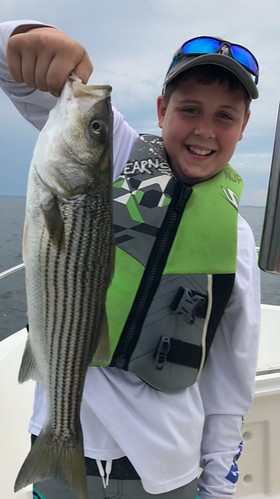
Nick Pirchio caught this striped bass fishing with his dad in Chesapeake Bay, when they tried some jigging after spotting some bait. Photo courtesy of Nick Pirchio
We’ve all heard it – 10 percent of anglers catch 90 percent of the fish. Good fishermen are often able to anticipate or adjust to changes in conditions or fish behavior. This trait lies deep in that hunter-gatherer instinct of those who can read the signs that Mother Nature provides them.
This kind of savvy and experience is usually part of what you’re paying for when hiring a charter or guide. Of course it is all the more exciting and certainly more rewarding when we can figure it out by ourselves.
In this first full week of summer, our freshwater fisheries have settled into a predictable pattern. Chesapeake Bay and ocean fisheries are usually in a state of flux and that is especially evident at the moment.
Don’t forget there is one more free fishing day coming up July 4. If you can think of someone who might like fishing, this is a great opportunity for someone to try the sport without buying a license.
Weekly Fishing Conditions Forecast Summary: June 27–July 3
The recent, heavy rains continue to impact Maryland waters, especially the Potomac River, as above-average flows reduce surface salinities and water clarity in many areas of the bay. Besides some possible rain Wednesday and Thursday, anglers will experience hot, sunny fishing conditions for most of the upcoming week.
Main bay water temperatures have reached the upper 70s as a result of warm and sunny conditions. Expect the hot, sunny weather to continue to push water temperatures toward the low 80s. These warmer temperatures will result in rockfish seeking cooler, deeper waters with adequate oxygen levels. Areas from Gunpowder Neck and Swan Point south to the Bay Bridge are showing poor bottom oxygen conditions below about 13 to 16 feet. However, other portions of the main bay and tidal rivers have much better oxygen conditions.
There will be above average tidal currents all week as a result of the full moon June 28.
For the full weekly fishing conditions summary and more detailed conditions in your area, please be sure to check out Click Before You Cast.
Upper Chesapeake Bay
As we progress into a warmer summer, water conditions are going to change with a profound effect on fishing. The heavy rain events we experienced in May and recent higher water temperatures are causing plankton blooms, which eventually cause oxygen depletion events in some of the deeper waters of the bay. This scenario played out this past weekend when striped bass in the upper bay moved in mass to an area between the Baltimore and Sandy Point lights along a 15 to 28-foot channel edge. As would be expected, fishermen moved with the fish, and there was a huge fleet stationed there this past weekend. Boats made the run from ports as far away as the southern region.
The action tended to last throughout the day and most would agree that the last hour of a tide offered the best fishing. Baits allowed to rest on the bottom at the back of a chum slick often caught the largest fish. There was some limited action at Swan Point and Love Point. Even at the Bay Bridge many found that the striped bass that could be found were suspended no deeper than 20 feet. Jigging at some of these sites offers a more peaceful setting than chumming in a dense fleet of boats. Trolling has been tough since the large and dense fleets of boats chumming have the best locations covered up. Trolling with surge tube lures (hoses) and gold spoons behind inline weights tends to be one of the best choices.
At the lower Susquehanna River region, live-lining white perch continues to be one of the better ways to fish for the striped bass that are holding in the lower areas of the river and channels leading into the bay. The Conowingo Dam has been in a power generating mode from the morning through the evening hours.
The chumming action at Hacketts seems to have shifted to above the Bay Bridge this week, but there has been some action at the edge of Thomas Point. Reports of any other chumming action in the middle bay region has been slim, but the Hill might be a location to scan with a depth finder. One can cover a lot of water in the search for fish and channel edges; ballast stone piles and the mouths of the tidal rivers are a good place to try. Trolling a mix of bucktails dressed with a sassy shad or twistertail, gold spoons, surge tube lures and crankbaits are popular.
The shallow water striped bass fishery is alive and well but with water temperatures in the upper 70s it is a very early morning bite and to a lesser extent a late evening affair. It’s not easy to get up early enough to be at your chosen honey hole, but the rewards are there. Topwater lures are in order for this fun light tackle action. Casting skipping bugs with a 7 wt. fly rod with a floating line or casting poppers with a spinning rod offer the most exciting action. Dark-colored lures tend to work the best in subdued light.
Fishing for white perch in the upper and middle bay continues to offer plenty of good opportunities. Large white perch are plentiful this season and can be caught in deeper waters on bottom rigs baited with bloodworms or grass shrimp. Casting small spinnerbaits or jigs with light tackle is a fun way to fish shoreline structure in the morning or evening hours.
It is summertime and chumming is often the most popular way to fish for striped bass. There are a few locations in the lower bay where some action can be found. The lower Potomac River steep channel edges near St. Georges Island, St. Clements Island and Piney Point have been some of the best places to try chumming. The rock piles north of Point Lookout and Buoy 70 have also been getting some attention.
Trolling is another option and a good way to cover plenty of water in the search for striped bass. A mixed spread of bucktails, swimshads, surge tubes and gold spoons have been the most popular choices. Jigging can be effective when suspended fish can be found suspended near channel edges or structure.
Casting topwater lures and swimshads along the shorelines of the tidal rivers and bay shores has been a fun and exciting way to fish this week. There are a lot of smaller striped bass in the mix but some nice fish are being caught. This is a low light, early morning or late evening fishery as water temperatures climb into the upper 70s in most areas. The Tangier and Pocomoke sounds also offer the chance to catch speckled trout in the process.
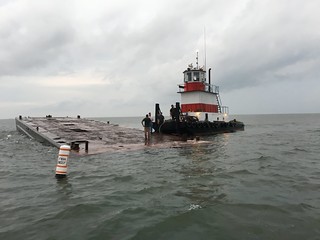
Photo by Michael Malpezzi
Bottom fishing for a mix of white perch, croaker and large spot has improved significantly in the past week in the lower sections of the region’s tidal rivers and sounds. Bloodworms, squid and peeler crab have been good baits to use. Blue catfish have become an increasing part of the catch, especially on the western shore, due to depressed salinities from all of the rain runoff.
The Maryland Artificial Reef Initiative recently sank a barge at the Tangier reef site near Fox Island Light, which will help provide more structure and habitat for fish such as striped bass and various bottom dwelling fish. If the cobia show up they may also hold close to such a structure. Tautog have also been documented on this reef site on concrete slabs from the Woodrow Wilson Bridge, which were deployed in 2007.
Recreational crabbing continues to improve each week, so catching a full bushel of crabs per outing in the middle and lower bay is now becoming more of a reality. The crabs tend to be shallow; using razor clams will greatly improve catches. We have a full moon June 28 so there will be a lot of shedding; if you can catch them before they shed you will have heavy crabs. Next week there will undoubtedly be a lot of light crabs.

Len Mogavero certainly was happy with this nice catch of crabs from the West River. Photo by Len Mogavero
Most all fish are showing some kind of adaption to warming water temperatures and bright sunlight this week. Many are retreating to cooler waters wherever and however they can find it, and they are feeding mostly in the early morning and evening hours.
Large reservoirs such as Deep Creek Lake will see walleye holding deep along steep rocky edges. Trout are also deep along the dam face and smallmouth bass are holding near floating docks, deep grass and rocky points.
At Deep Creek Lake, largemouth bass can be found near shallow structure during the early morning and late evening hours. Grass is often the favorite place for largemouth bass to search for food in the form of small baitfish, frogs and crayfish. Casting topwater lures, spinnerbaits and small lipless crankbaits is a proven tactic. As the sun becomes brighter, the bass will retreat to shade under floating docks, fallen treetops, brush or under thick grass. Stick worms, grubs and soft plastics are a good choice to target these areas.
Anglers will see this same pattern of behavior for largemouth bass in the many reservoirs, ponds and tidal rivers throughout Maryland. In tidal waters, the tide plays another factor. A high tide will allow largemouth bass to move into grass and spatterdock and a lower tide will cause them to be on the edges of these areas looking for baitfish moving to deeper waters.
The upper Potomac River is still running a bit brisk this week but flood levels have dropped significantly since last weekend. It is not safe to wade and only the most experienced should attempt to be out on the water. The tidal Potomac is feeling the effects of last week’s flood conditions so water clarity, levels and floating debris are things to consider. Fishing for largemouth bass, blue catfish and northern snakeheads continues to be good in the main stem of the river and tributaries.
Summertime trout fishing in the western and central regions of the state are best done now with fly-fishing or light spinning tackle. The many special trout management waters that are catch-and-release offer wonderful opportunities. The delayed harvest areas this month continue to be open to a creel limit of five fish and for those wishing to take some trout home, this is a great opportunity.
Lazy summer evenings are a great time to break out a 4 or 5 wt. fly rod and enjoy some fishing for bluegills and other species of sunfish. Small rubber-legged poppers offer a lot of fun action when fishing from a canoe or kayak on small ponds. Using larger poppers can also bring on strikes from largemouth bass. In many of the tidal areas, northern snakeheads can add to the excitement of a surface crash on a topwater deer hair or cork popper.
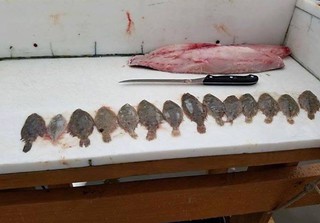
Levi Dunlap caught a 29-inch striped bass at the inlet recently and found 14 small summer flounder in the fish’s stomach. Striped bass are known to be opportunistic feeders but this is something I have never seen. Photo by Levi Dunlap
The kingfish seem to have moved on from the Maryland beaches; they are still being caught but not to the degree they were a week or two ago. Bloodworms, squid and small strips of cut bait have been a good choice for the kingfish and a mix of blowfish and flounder.
A few large striped bass are still being caught now and then but those fishing with large cut baits are mostly catching skates, stingrays and small inshore sharks.
At the inlet, sheepshead are becoming more common and are being caught on sand fleas at the South Jetty. Flounder are being caught at the inlet and a few legal-sized striped bass in the early morning and evening hours by casting bucktails and swimshads or by drifting fresh cut baits or live eels.
Flounder fishing has been very good in the back bay channels. Fishing with squid or live minnows has been popular but the largest flounder are often being caught on white Gulp mullet-type baits dressed with a strip of squid.
Sea bass fishing at the offshore wreck and reef sites has been good and captains report that flounder are beginning to be a larger portion of the catch. They also mentioned that the sites farther offshore have been producing the largest sea bass.
Fishing for a mix of offshore pelagic species has really kicked into gear for Ocean City anglers. Limits of yellowfin tuna and a mix of Bluefin tuna, bigeye tuna, dolphin and white marlin are being caught at Poorman’s, Baltimore, Wilmington and Norfolk canyons.
“I love fishing. I can think of no greater pleasure than to sit alone toward the evening by the water and watch a float.” — Anton Chekhov, 1896
 ABOUT THE AUTHOR Keith Lockwood has been writing the Fishing Report since 2003 and has had a long career as a fisheries research biologist since 1973. Over the course of his career he has studied estuarine fishery populations, ocean species, and over a decade long study of bioaccumulation of chemicals in aquatic species in New Jersey. Upon moving to Oxford on the eastern shore of Maryland; research endeavors focused on a variety of catch-and-release studies as well as other fisheries related research at the Cooperative Oxford Laboratory. Education and outreach to the fishing public has always been an important component to the mission of these studies. Keith is an avid outdoorsman enjoying hunting, fishing, bird dogs, family and life on the eastern shore of Maryland.
ABOUT THE AUTHOR Keith Lockwood has been writing the Fishing Report since 2003 and has had a long career as a fisheries research biologist since 1973. Over the course of his career he has studied estuarine fishery populations, ocean species, and over a decade long study of bioaccumulation of chemicals in aquatic species in New Jersey. Upon moving to Oxford on the eastern shore of Maryland; research endeavors focused on a variety of catch-and-release studies as well as other fisheries related research at the Cooperative Oxford Laboratory. Education and outreach to the fishing public has always been an important component to the mission of these studies. Keith is an avid outdoorsman enjoying hunting, fishing, bird dogs, family and life on the eastern shore of Maryland.

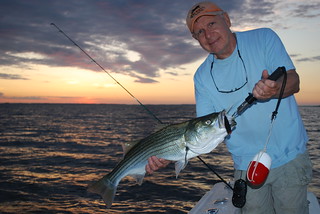
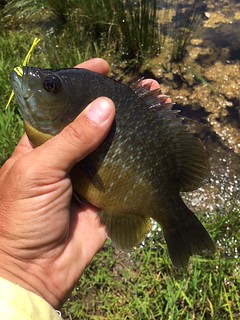
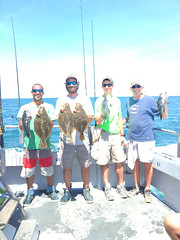
 1-888-373-7888
1-888-373-7888 233733
233733